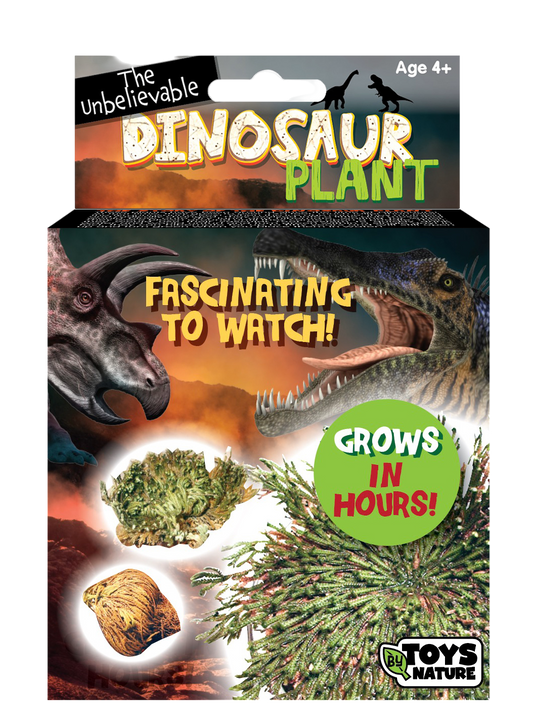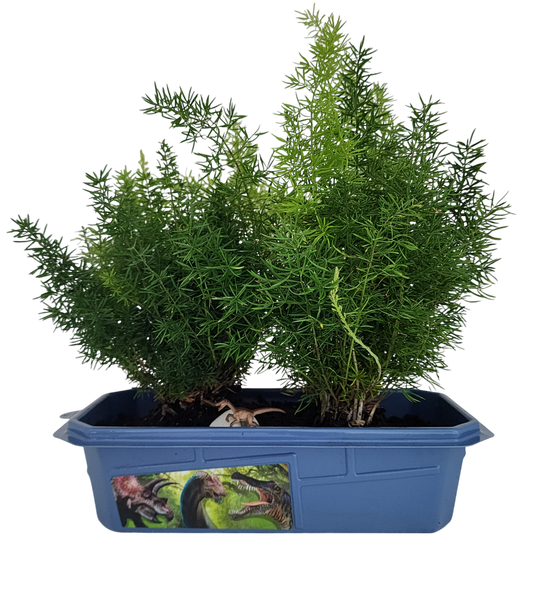Automatic Free Shipping on Orders $50.00 and more!
Collection: Dinosaur Plants Collection
Grow plants that were around when Dinosaurs roamed the earth. Flowering plants didn’t appear until the late dinosaur era. For most of their existence, dinosaurs fed on non-flowering plants, including ferns, cycads, and conifers, which dominated the prehistoric landscape. All the kits include special themed accents, and some even have a little dinosaur! Create your own prehistoric garden that fits on a windowsill!! These plants take about a month to sprout and are very unique, special and long-lasting. All the plants in these creations are prehistoric!
Prehistoric Palms
These are not actually a palm, but a cycad. Cycads formed an extensive portion of the flora in the time of the dinosaurs. There is no doubt herbivorous dinosaurs grazed contentedly among these plants. The dinosaurs disappeared, however, and so did most of the cycads – except for a few incredibly resilient species that still exist today. They are now referred to as living fossils, for they have remained virtually unchanged, and give us a glimpse into a long-distant past.
These plants have beautiful leaf colors, from light green, to sage, to blue-gray, and is stunning even as a seedling. Although it can live to be 1,500 years old and eventually achieve a trunk height of 10 feet.
Prehistoric Ferns
What do ferns and dinosaurs have in common? They were both present in the Mesozoic era. Ferns are one of the oldest living things dating back 300 million years ago! Unlike the dinosaurs, the ferns escaped extinction and thrive in their natural habitats or in landscaped gardens on every continent in the world. These full, lush plants are not actually ferns though, but members of the lily family (Liliaceae). Their long, arching stems are densely covered with short, needle-like leaflets giving the plants a delicate appearance.
Prehistoric Pines
Before the evolution of flowering plants dinosaurs ate things like pine needles, ferns and cycads. This pine would have been a tasty snack for any dinosaur tall enough to reach it! The Austrian Pine is an extremely tolerant pine of adverse soil conditions and air pollution.
The Austrian Pine is a native of Austria, northern Italy and Yugoslavia. It was introduced to the United States in 1759. Its forebears were likely worshipped by the Romans over 2000 years ago. Over 217 million were planted during the Unites States’ great dust bowl shelterbelt project. They have thrived for over 200 years in some of the worst soil and climate conditions America has to offer.
Did you know?
The majority of Dinosaurs were vegetarians!
Paleontologists believe the stegosaurus had a brain no larger than a walnut!
When dinosaurs first appeared, all the earth’s continents were joined together in one super-continent known as “Pangea”.
Dinosaurs prospered for over 150 million years. They first appeared in the Triassic Period (248 to 213 million years ago) and were the dominant land animals through the entire Jurassic period, and to the end of the Cretaceous period (65 million years ago).
Tiny grass-like plants emerged at the end of the dinosaur era, hinting that some dinosaurs, like certain herbivores, may have been among the earliest grass-eaters.
Ancient Trees Were Enormous: Plants like the giant sequoias and redwoods existed during the dinosaur era, reaching heights of over 100 feet. These massive trees were likely favored for shelter by some dinosaur species.
Velociraptor is one of the well-known small, predatory dinosaurs. About the size of a turkey, the Velociraptor is said to be a cunning and calculating meat-eater. It is believed that this dinosaur hunted in groups, just like many carnivorous animals today, such as wolves and the big cats.
All the familiar types of dinosaurs died off at the end of the Cretaceous period. The most popular theory today is that an asteroid hit the earth, blocking out the sunlight so that there was not enough food available.
-
Dinosaur Domain Biosphere Terrarium
Vendor:Toys By NatureRegular price $29.99 USDRegular priceUnit price / per -
Dinosaur Plant - Multipack of 3
Vendor:Toys By NatureRegular price $24.99 USDRegular priceUnit price / per -
Prehistoric Dinosaur Land Mini World Terrarium
Vendor:Toys By NatureRegular price $19.99 USDRegular priceUnit price / per -
Resurrection Plant - Multipack of 3
Vendor:Unique GardenerRegular price $24.99 USDRegular priceUnit price / per








